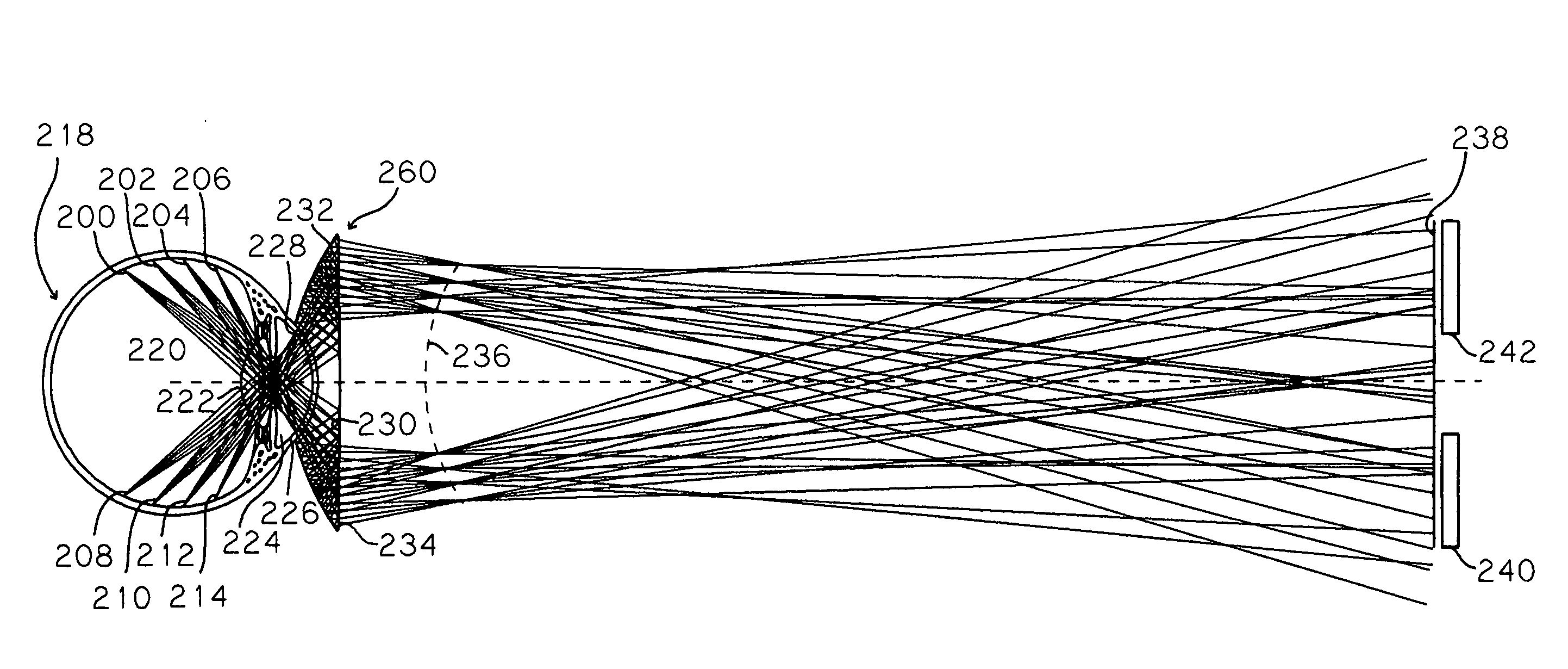Real image forming eye examination lens utilizing two reflecting surfaces
- Summary
- Abstract
- Description
- Claims
- Application Information
AI Technical Summary
Benefits of technology
Problems solved by technology
Method used
Image
Examples
first embodiment
[0037]Referring to FIG. 1, there is shown a ray tracing and schematic cross-sectional view of a lens layout of an exemplary single element gonioscopy lens 30 according to the invention. Lens 30 is small in diameter, lightweight and incorporates refracting surfaces that are balanced to minimize chromatic aberration. The real image produced by this lens is well within the range of motion of the slit lamp biomicroscope and the view provided is stereoscopic across the entire visualized field. The lens is made of optical quality polymethylmethacrylate with an index of refraction of approximately Nd=1.492 and an Abbe number of approximately Vd=55.3. Alternatively, the lens may be made of N-BK7 glass, having an index of refraction of approximately Nd=1.517 and an Abbe number of approximately Vd=64.2. The two lenses have identical design and prescription values with the plastic lens offering greater ease of manufacture and the glass lens offering enhanced scratch resistance, durability and ...
second embodiment
[0046]Referring to FIG. 3, there is shown a schematic cross-sectional view of a lens layout of an exemplary doublet gonioscopy lens according to the invention, wherein lens 70 comprises a cemented lens including posterior element 72 and anterior element 74. The lens provides a high magnification image exhibiting low chromatic error.
[0047]Posterior element 72 is made of optical quality polycarbonate having an index of refraction of approximately Nd=1.585 and an Abbe number of approximately Vd=29.9 and anterior element 74 is made of S-LAH64, having an index of refraction of approximately Nd=1.788 and an Abbe number of approximately Vd=47.4. The two element 72 and 74 are glued together at their interface using a suitable optical adhesive such as NOA 68 or NOA 78 (available from Norland Products).
[0048]Referring to FIG. 3, light rays 42 and 44 emanating from the stated iridocorneal and mid-peripheral iris locations of anterior chamber 46 of schematic eye 48 pass through the cornea 50 an...
third embodiment
[0053]Referring to FIG. 4, there is shown a schematic cross-sectional view of a lens layout of an exemplary doublet gonioscopy lens according to the invention, wherein lens 110 comprises a cemented lens including posterior element 112 and anterior element 114. The lens provides sharp imaging characteristics at a slightly reduced magnification and provides protection of the anterior mirrored surface by way of embedment at the cemented interface.
[0054]Posterior element 112 is made of optical quality polymethylmethacrylate having an index of refraction of approximately Nd=1.492 and an Abbe number of approximately Vd=55.3 and anterior element 114 is made of optical quality polycarbonate, having an index of refraction of approximately Nd=1.585 and an Abbe number of approximately Vd=29.9. The two elements 112 and 114 are glued together at their interface using a suitable optical adhesive as previously described.
[0055]Referring to FIG. 4, light rays 82 and 84 emanating from the stated irid...
PUM
 Login to View More
Login to View More Abstract
Description
Claims
Application Information
 Login to View More
Login to View More - R&D
- Intellectual Property
- Life Sciences
- Materials
- Tech Scout
- Unparalleled Data Quality
- Higher Quality Content
- 60% Fewer Hallucinations
Browse by: Latest US Patents, China's latest patents, Technical Efficacy Thesaurus, Application Domain, Technology Topic, Popular Technical Reports.
© 2025 PatSnap. All rights reserved.Legal|Privacy policy|Modern Slavery Act Transparency Statement|Sitemap|About US| Contact US: help@patsnap.com



